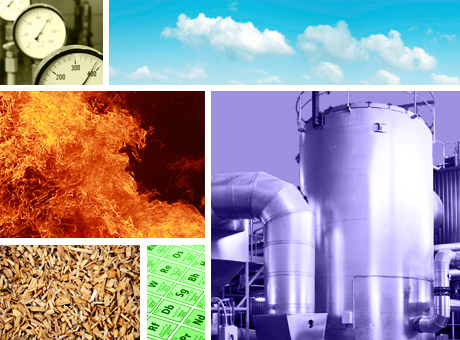Fluidized-Bed Combustors for Biomass Boilers
Fluidized-Bed Combustors for Biomass Boilers


Biomass combustion technologies burn a variety of biomass fuels, including wood, crop remnants, wood pulp and chips, and municipal solid waste. These materials are difficult to burn efficiently in conventional furnaces because of several inherent properties, including overall low heating value, low fixed carbon, and higher moisture content.
A boiler is a better choice for burning biomass because it transfers the heat of combustion into steam. It is also a cleaner reaction when it comes to agricultural waste—in conventional combustion systems potassium and sodium compounds contained in plant matter react with other elements during combustion, creating slag deposits; this is not generally a problem for biomass boilers.
Efficiency of the Combustion Process
Fluidized-bed boilers are the most common type of boiler recommended for biomass fuel, which is burned within a hot bed of inert particles, typically sand. The fuel-particle mix is suspended by an upward flow of combustion air within the bed. As velocities increase the gas/solid mix exhibits fluid-like properties. According to the EPA's "Combined Heat and Power Partnership Biomass CHP Catalog," the scrubbing action of the bed material on the fuel also enhances the combustion process by "stripping away the CO2 and solids residue (char) that normally forms around the fuel particles . . . allowing oxygen to reach the combustible material more readily and increase the rate and efficiency of the combustion process."
This process also increases heat transfer and allows for lower operating temperatures: bed temperatures range about 1,400° F to 1,600° F, far less than the 2,200° F for a spreader stoker boiler. Lower boiler temperatures also produce less nitrogen oxide, an environmental and regulatory benefit when burning high nitrogen-content wood and biomass fuels. Suflur dioxide emissions from wood waste and biomass are generally insignificant; however, if sulfur is a contaminant it can be neutralized by adding limestone to the fluid bed.
Bubbling or Circulating?
Boiler engineers can choose between two main types of fluidized-bed boilers—bubbling fluidized bed (BFB) and circulating fluidized bed (CFB). In BFB boilers the velocity of the combustion air is low enough that the fluidized particles remain in the lower furnace; in a CFB unit the velocity is greater and hot particles are circulated through the entire range of the boiler combustion zone. The fuel is in contact with the particles and effective mixing and combustion allows good efficiency and low emissions. Typically 97% to 99% of all burnable carbon in the fuel stream is combusted, even hard-to-burn materials. Boiler thermal efficiencies can be as high as 87% or more. Although both BFB and CFB systems are effective with biofuels, CFB is especially suitable for large boiler load ranges.
"Bed combustion temperature control is fundamental to fluid-bed boilers," writes J. P. DeFusco in A Comparison of Fluid-Bed Technologies for Renewable Energy Applications (Babcock & Wilcox Power Generation Group, 2010). "Bed temperature is controlled to limit emissions and to limit bed material agglomeration."
Agglomeration can be caused by alkaline ash, other metals, and phosphates combining with alumina and silica to form low-melting-point eutectics that coat the bed particles. If alkali concentrations are too high the coatings melt and bond the particles together; these larger agglomerated particles become too heavy and interfere with the fluidization process.
CFB technology provides fuel flexibility in that it can burn wood and high Btu fuels. Babcock & Wilcox report that CFBs are common in Europe for renewable energy projects that burn lower moisture fuels, such as clean urban waste wood.
"Making the decision between a BFB or CFB system is not always obvious and should be evaluated on a case-by-case basis," advises DeFusco. "Parasitic power requirements play a very important role in the evaluation process and ultimately system reliability is critical for any given project. That evaluation begins with a thorough understanding of fuels, fuel variability, and ash characteristics while being further influenced by emissions requirements."
Mark Crawford is an independent writer.
A boiler is a better choice for burning biomass because it transfers the heat of combustion into steam.



